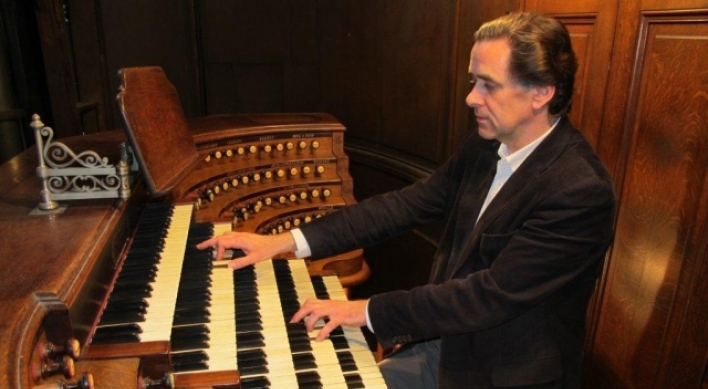OSAKA, Japan ― “Matsushima-ya!” Nine men and women in their 50s and 60s enthusiastically shouted as they watched a video of a kabuki play in Chuo Ward, Osaka. They were being schooled in the art of yelling stage names and pertinent expressions when kabuki actors appear on stage or strike impressive poses.
Known as “omuko,” the art of yelling at the theater is an indispensable part of kabuki tradition that has been passed down among enthusiasts, who are typically seated in the gallery. Their yelling is intended to accentuate the performance and cheer on the performers. The term can also be used to refer to members of the audience and to the gallery itself.
Omuko usually shout the stage family names of actors, their generation numbers or the names of the places where they live. For some plays that involve dialogue between the cast and the audience, it is an absolute must.
The nine people attending the training session were members of the Kansai Kabuki o Aisuru-kai, a group of kabuki fans in the Kansai region. Since April 2011, the group has held workshops every month or two to teach the art of omuko.
These kabuki fans were taught by Kazuo Kaibori, an 82-year-old member of Hatsune-kai, the only omuko group in the Kansai region authorized by kabuki theaters.
“The shout came too late.” Kaibori, who boasts a career of about 40 years as an omuko, lectured for an hour to the members with the aid of the video. “In this scene, you should shout the (actor’s) stage family name.”
According to Kaibori, shouting at the right time is the most difficult part. It should not be done when the actors are speaking. Though anyone can do it, training and experience are necessary.
“You need to adapt your pitch and tone to the scene,” Kaibori said. “For a sad scene, you need to shout out with the same sad feeling. Omuko are like performers who sit in the audience.”
Megumi Kawata, a 60-year-old homemaker from Minoo, Osaka Prefecture, started going to kabuki after her children grew up.
“I can shout at the TV monitor without worrying about ruining the play,” Kawata said. “Now, when I watch kabuki at the theater, I shout in my mind. Someday I’ll shout for real.”
The training session started with the suggestion by Takashi Yoshiura, 57, manager of Osaka Shochiku-za theater.
Hatsune-kai once had 15 members, which allowed for a rotation in which one or two were always at the theater for every play. But with the members aging, that number has gradually dwindled to fewer than 10 at any given time, resulting in an increased workload. Moreover, due to health issues, there have been some days when no members were present for performances.
After acquiring techniques of the art at the training session, three people joined Hatsune-kai. Currently, it has 11 members.
“Kabuki is greatly enhanced by omuko,” said Yoshiura, who does omuko by himself when no one else is available. “There were certain times in the past when kabuki was unpopular, but omuko people managed to preserve it by serving as regular patrons. I hope more people learn the art.”
The same type of schooling takes place elsewhere, too.
In Toyooka, Hyogo Prefecture, about 20 local residents set up the omuko group Tsuru no Kai in 2013 at the urging of popular kabuki actor Kataoka Ainosuke. Its members, who are in their 40s to 70s, train once a month.
Ainosuke has been performing at Izushi Eirakukan, a long-established venue in the city. The oldest existing theater in the Kinki region, Izushi Eirakukan reopened in 2008 ― 44 years after its closure ― after restoration work. Since then, the space has been used to host annual kabuki performances.
At Namba Parks Cinema movie theater in Naniwa Ward, Osaka, hands-on omuko workshops have been held on three occasions. A total of 900 people have attended its Cinema Kabuki series ― featuring films of kabuki plays ― where audiences are encouraged to shout as the plays are shown on the screen.
By Yaeko Sugiyama
(The Yomiuri Shimbun)
Known as “omuko,” the art of yelling at the theater is an indispensable part of kabuki tradition that has been passed down among enthusiasts, who are typically seated in the gallery. Their yelling is intended to accentuate the performance and cheer on the performers. The term can also be used to refer to members of the audience and to the gallery itself.
Omuko usually shout the stage family names of actors, their generation numbers or the names of the places where they live. For some plays that involve dialogue between the cast and the audience, it is an absolute must.
The nine people attending the training session were members of the Kansai Kabuki o Aisuru-kai, a group of kabuki fans in the Kansai region. Since April 2011, the group has held workshops every month or two to teach the art of omuko.
These kabuki fans were taught by Kazuo Kaibori, an 82-year-old member of Hatsune-kai, the only omuko group in the Kansai region authorized by kabuki theaters.
“The shout came too late.” Kaibori, who boasts a career of about 40 years as an omuko, lectured for an hour to the members with the aid of the video. “In this scene, you should shout the (actor’s) stage family name.”
According to Kaibori, shouting at the right time is the most difficult part. It should not be done when the actors are speaking. Though anyone can do it, training and experience are necessary.
“You need to adapt your pitch and tone to the scene,” Kaibori said. “For a sad scene, you need to shout out with the same sad feeling. Omuko are like performers who sit in the audience.”
Megumi Kawata, a 60-year-old homemaker from Minoo, Osaka Prefecture, started going to kabuki after her children grew up.
“I can shout at the TV monitor without worrying about ruining the play,” Kawata said. “Now, when I watch kabuki at the theater, I shout in my mind. Someday I’ll shout for real.”
The training session started with the suggestion by Takashi Yoshiura, 57, manager of Osaka Shochiku-za theater.
Hatsune-kai once had 15 members, which allowed for a rotation in which one or two were always at the theater for every play. But with the members aging, that number has gradually dwindled to fewer than 10 at any given time, resulting in an increased workload. Moreover, due to health issues, there have been some days when no members were present for performances.
After acquiring techniques of the art at the training session, three people joined Hatsune-kai. Currently, it has 11 members.
“Kabuki is greatly enhanced by omuko,” said Yoshiura, who does omuko by himself when no one else is available. “There were certain times in the past when kabuki was unpopular, but omuko people managed to preserve it by serving as regular patrons. I hope more people learn the art.”
The same type of schooling takes place elsewhere, too.
In Toyooka, Hyogo Prefecture, about 20 local residents set up the omuko group Tsuru no Kai in 2013 at the urging of popular kabuki actor Kataoka Ainosuke. Its members, who are in their 40s to 70s, train once a month.
Ainosuke has been performing at Izushi Eirakukan, a long-established venue in the city. The oldest existing theater in the Kinki region, Izushi Eirakukan reopened in 2008 ― 44 years after its closure ― after restoration work. Since then, the space has been used to host annual kabuki performances.
At Namba Parks Cinema movie theater in Naniwa Ward, Osaka, hands-on omuko workshops have been held on three occasions. A total of 900 people have attended its Cinema Kabuki series ― featuring films of kabuki plays ― where audiences are encouraged to shout as the plays are shown on the screen.
By Yaeko Sugiyama
(The Yomiuri Shimbun)
-
Articles by Korea Herald







![[KH Explains] How should Korea adjust its trade defenses against Chinese EVs?](http://res.heraldm.com/phpwas/restmb_idxmake.php?idx=644&simg=/content/image/2024/04/15/20240415050562_0.jpg&u=20240415144419)











